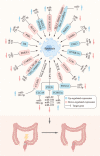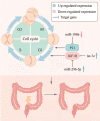Mechanisms of microRNA action in rectal cancer radiotherapy
- PMID: 35943251
- PMCID: PMC9746734
- DOI: 10.1097/CM9.0000000000002139
Mechanisms of microRNA action in rectal cancer radiotherapy
Abstract
Preoperative neoadjuvant chemoradiotherapy, combined with total mesorectal excision, has become the standard treatment for advanced localized rectal cancer (RC). However, the biological complexity and heterogeneity of tumors may contribute to cancer recurrence and metastasis in patients with radiotherapy-resistant RC. The identification of factors leading to radioresistance and markers of radiosensitivity is critical to identify responsive patients and improve radiotherapy outcomes. MicroRNAs (miRNAs) are small, endogenous, and noncoding RNAs that affect various cellular and molecular targets. miRNAs have been shown to play important roles in multiple biological processes associated with RC. In this review, we summarized the signaling pathways of miRNAs, including apoptosis, autophagy, the cell cycle, DNA damage repair, proliferation, and metastasis during radiotherapy in patients with RC. Also, we evaluated the potential role of miRNAs as radiotherapeutic biomarkers for RC.
Copyright © 2022 The Chinese Medical Association, produced by Wolters Kluwer, Inc. under the CC-BY-NC-ND license.
Conflict of interest statement
The authors declare no competing financial interests.
Figures




Similar articles
-
MicroRNA expression profile associated with response to neoadjuvant chemoradiotherapy in locally advanced rectal cancer patients.Radiat Oncol. 2012 Nov 20;7:195. doi: 10.1186/1748-717X-7-195. Radiat Oncol. 2012. PMID: 23167930 Free PMC article.
-
TTI1 contributes to radioresistance by activating ATM pathway in rectal cancer.J Transl Med. 2025 Jun 13;23(1):652. doi: 10.1186/s12967-025-06648-3. J Transl Med. 2025. PMID: 40514657 Free PMC article.
-
MicroRNA-130a modulates a radiosensitivity of rectal cancer by targeting SOX4.Neoplasia. 2019 Sep;21(9):882-892. doi: 10.1016/j.neo.2019.07.005. Epub 2019 Aug 3. Neoplasia. 2019. PMID: 31387015 Free PMC article.
-
Targeting MicroRNAs in Prostate Cancer Radiotherapy.Theranostics. 2017 Jul 23;7(13):3243-3259. doi: 10.7150/thno.19934. eCollection 2017. Theranostics. 2017. PMID: 28900507 Free PMC article. Review.
-
Molecular profiling of locally-advanced rectal adenocarcinoma using microRNA expression (Review).Int J Oncol. 2017 Aug;51(2):393-404. doi: 10.3892/ijo.2017.4045. Epub 2017 Jun 14. Int J Oncol. 2017. PMID: 28627602 Review.
Cited by
-
Radiotherapy Metastatic Prostate Cancer Cell Lines Treated with Gold Nanorods Modulate miRNA Signatures.Int J Mol Sci. 2024 Feb 27;25(5):2754. doi: 10.3390/ijms25052754. Int J Mol Sci. 2024. PMID: 38474003 Free PMC article.
References
-
- Sung H, Ferlay J, Siegel RL, Laversanne M, Soerjomataram I, Jemal A, et al. . Global Cancer Statistics 2020: GLOBOCAN estimates of incidence and mortality worldwide for 36 cancers in 185 countries. CA Cancer J Clin 2021; 71:209–249. doi: 10.3322/caac.21660. - PubMed
-
- Benson AB, Venook AP, Al-Hawary MM, Arain MA, Chen YJ, Ciombor KK, et al. . NCCN guidelines insights: rectal cancer, version 6.2020. J Natl Compr Canc Netw 2020; 18:806–815. doi: 10.6004/jnccn.2020.0032. - PubMed
-
- Martin ST, Heneghan HM, Winter DC. Systematic review and meta analysis of outcomes following pathological complete response to neoadjuvant chemoradiotherapy for rectal cancer. Br J Surg 2012; 99:918–928. doi: 10.1002/bjs.8702. - PubMed
-
- de Campos-Lobato LF, Stocchi L, da Luz Moreira A, Geisler D, Dietz DW, Lavery IC, et al. . Pathologic complete response after neoadjuvant treatment for rectal cancer decreases distant recurrence and could eradicate local recurrence. Ann Surg Oncol 2011; 18:1590–1598. doi: 10.1245/s10434-010-1506-1. - PubMed
Publication types
MeSH terms
Substances
LinkOut - more resources
Full Text Sources

